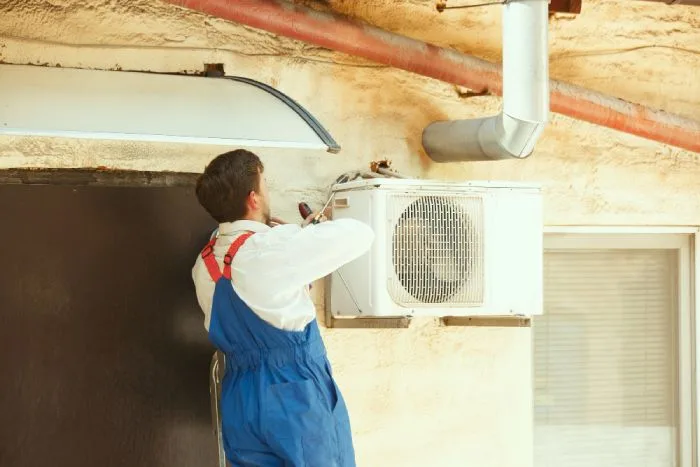When it comes to creating a comfortable and energy-efficient indoor environment, the role of ductwork design cannot be overstated. It serves as the circulatory system of your HVAC (heating, ventilation, and air conditioning) system, responsible for distributing conditioned air throughout your home or commercial space. However, its importance often goes unnoticed until problems arise.
In this blog, we’ll explore the crucial aspects of ductwork design and its significance in ensuring efficient AC installation. We’ll also shed light on the potential challenges and common problems that can emerge when it is not given the attention it deserves.
What Does Ductwork Do?
Ductwork is crucial in efficiently distributing cool air throughout a space, ensuring optimal comfort levels. It acts as the conduit that carries conditioned air from the air conditioning unit to every room in a building. It also helps remove stale air, odors, and pollutants from indoor spaces. By circulating fresh air and filtering out contaminants, it improves indoor air quality and creates a healthier environment for occupants.
Additionally, it can help balance temperatures between different rooms by evenly distributing cooled air. This ensures that there aren’t any hot spots or cold drafts in certain areas of the building, leading to consistent comfort throughout.
The Fundamentals of Effective Ductwork Design
The location of the ductwork within your home or building can greatly impact its efficiency and effectiveness. It’s important to avoid using certain products that can negatively affect airflow balancing and overall performance.
If you have a basement, there are specific suggestions to consider for your ductwork design layout. Consulting with an air conditioning in Sarasota in HVAC design can provide valuable expertise and guidance throughout the process.
Ensure Ducts Are Sealed
To maximize the energy efficiency of your AC installation, make sure you seal your ducts properly. This is a crucial step in ensuring that cool air doesn’t escape through leaks or gaps. By sealing your ducts, you can prevent these issues and ensure that all the cooled air is delivered directly to where it’s needed.
When ducts are not sealed, air can easily leak out into unconditioned spaces such as attics or crawlspaces, resulting in wasted energy and higher utility bills. Not only does this reduce the effectiveness of your AC system, but it also puts unnecessary strain on the unit as it tries to compensate for the lost air.
Location Matters
It’s important to ensure that there are no obstructions blocking airflow around the unit, such as shrubs or furniture. Adequate ventilation around the unit will allow for efficient operation and prevent overheating. The placement of the unit plays a crucial role in maintaining cool temperatures throughout your space.
Ideally, it should be installed in a shaded area away from direct sunlight and heat sources such as appliances or electronics. This will prevent the unit from working harder than necessary to cool down the surrounding air, leading to increased energy consumption and higher utility bills.
Products to Avoid
It’s crucial to steer clear of certain affordable air conditioner products that may not meet your cooling needs and could potentially lead to higher energy consumption and increased utility bills.
- If the AC unit is too small for your space, it’ll have to work harder to cool the area, resulting in inefficient operation and higher energy usage.
- An oversized AC unit can also be problematic. It may cycle on and off frequently, which not only wastes energy but also puts unnecessary strain on the system.
Another product to avoid when considering ductwork design is low-quality insulation. Insufficient or poorly installed insulation can lead to air leaks, reducing the efficiency of your AC system. This means that cooled air might escape through gaps before it reaches its intended destination, resulting in wasted energy and decreased comfort levels in your home.
Basement Suggestions
When planning your basement, one important aspect is the potential for proper air circulation and ventilation. Since basements are typically underground or partially underground, they can be prone to dampness and poor air quality if not properly ventilated. Here are a few suggestions to ensure that your basement has efficient airflow:
- Install vents or registers — Adding vents or registers in strategic locations throughout the basement allows fresh air to circulate and prevents stale air from accumulating. This will help reduce humidity levels and improve overall air quality.
- Consider a dehumidifier — Basements tend to have higher moisture levels due to their proximity to the ground. Installing a dehumidifier can help remove excess moisture from the air, reducing the risk of mold growth and musty odors.
Use ceiling fans or portable fans — Moving air helps distribute heat evenly and prevents stagnant hot or cold air pockets. Installing ceiling fans or using portable fans can aid in circulating warm and cool air throughout the space, making it more comfortable for occupants.
Why You Should Consult a Professional For Your Ductwork Design

Hiring a professional for your basement project can provide you with expert guidance and ensure that your ventilation system will consider factors such as the size of your basement, the number of rooms, and any existing obstacles that may affect airflow.
Consulting a professional is crucial for ductwork design considerations and efficient AC installation. They have the knowledge and experience to assess your specific needs and recommend the best layout for maximum efficiency.
- Proper airflow distribution is essential for maintaining consistent temperatures throughout the space and avoiding hot or cold spots.
- A professional can conduct load calculations to determine the exact amount of air needed in each room based on factors like square footage, insulation levels, and window sizes.
- Professionals also have expertise, and they understand how different materials and shapes impact air distribution and can recommend options that minimize resistance and maximize efficiency.
- They also know about building codes and regulations related to installation, ensuring everything is up to code for safety purposes. With their help, you can avoid costly mistakes or potential issues by installing a well-designed ventilation system in your basement.
Considerations of Effective Ductwork Design
Effective ductwork design plays a vital role in achieving efficient AC installation. By considering factors such as layout, sizing, and insulation, you can ensure optimal airflow distribution and energy efficiency throughout your home. Consulting a professional in this process will help you make informed decisions that result in a well-designed ductwork design system that keeps you comfortable while minimizing energy costs.
- One key consideration is minimizing the length and number of bends in the ducts. Straighter ductwork design runs with minimal bends allowing for better airflow and reduced resistance, ensuring that cool air can reach every corner of your home without unnecessary strain on the system.
- An important consideration is the proper AC duct sizing. Undersized or oversized ducts can lead to inefficient cooling and increased energy consumption. A professional can calculate the ideal size based on factors such as room size, ceiling height, insulation levels, and more.
- Additionally, it’s crucial to consider insulation. Properly insulated ductwork design prevents condensation and heat loss, reducing energy waste and improving indoor air quality.
Conclusion
At Tropic Air Conditioning, our professionals understand the importance of proper ductwork design to ensure efficient AC installation and boost quality air indoors. We can help you make informed decisions that will help contribute to a more comfortable and energy-efficient home or commercial space — an investment that will pay off in both comfort and savings in the long run. Contact us today.




